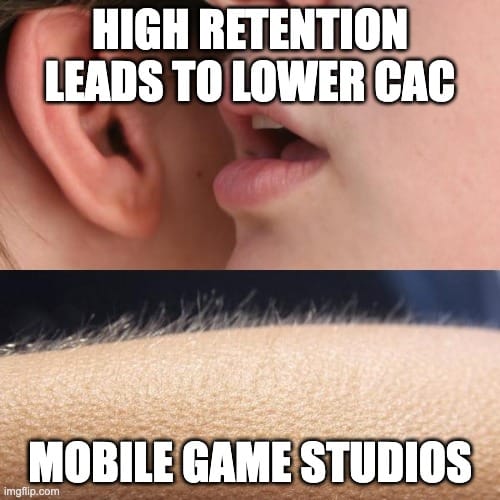Understand How to Retain Mobile Game Users Longer
Contents
- Player Retention in Mobile Gaming
- The Importance of Player Retention
- 9 Strategies to Drive Better Mobile Game Retention
- 1. Optimize the Onboarding Experience
- 2. Incentivize and Reward Engagement
- 3. Leverage Multi-Channel Messaging
- 4. Continuously Introduce Fresh Content
- 5. Foster a Sense of Community
- 6. Leverage Personalization and Relevance
- 7. Embrace Social Dynamics
- 8. Leverage Partnerships
- 9. Continuously Analyze and Iterate
- Conclusion

Player Retention in Mobile Gaming
If you’re someone who works in a mobile game studio, you know that retaining players is as crucial as attracting them. With increasing user acquisition costs and fierce competition, success hinges on keeping players engaged over time. Industry data indicates that most mobile apps lose about 80% of their users within just three days after installation, and only 2.4% remain active after 30 days.
This highlights the importance of focusing on player retention to sustain revenue and gain a competitive edge. Game studios that master retention can unlock sustained revenue streams, higher lifetime values, and a competitive edge in this competitive landscape.
The Importance of Player Retention
Achieving robust player retention is key to a game's success for several reasons:
- Demonstrates User Loyalty
A high retention rate signifies a dedicated user base, indicating that the game resonates with its audience and fosters a sense of loyalty. - Sustained Revenue and Profitability
Retaining players are more often than not consistently engaged, which in turn drive revenue through in-app purchases, subscriptions, and ads. - Elevated Lifetime Value (LTV)
The longer a user remains active within a game, the higher their potential lifetime value becomes, as they are likely to contribute to revenue streams over an extended period. - Unlocking Long-Term Monetization Opportunities
A loyal user base game studios to explore different monetization avenues, such as limited-time offers, exclusive content, and premium experiences, without the constant need for recurring costly user acquisition campaigns. - Solidifying App Reputation and Organic Growth
Highly engaged users are more likely to leave positive reviews, share their experiences with friends and family, and contribute to organic growth through word-of-mouth or social media advocacy. - Cost Savings on User Acquisition
Retaining existing users is more cost-effective than continuously acquiring new ones, as acquisition requires substantial investments in marketing, advertising, and other acquisition strategies.

9 Strategies to Drive Better Mobile Game Retention
Achieving stellar player retention requires a multifaceted approach that encompasses various aspects of game design, user experience, and engagement tactics. Here are ten proven strategies to keep players hooked and maximize retention:
1. Optimize the Onboarding Experience
The onboarding process is the first impression a player has of your game, and it can make or break their decision to continue playing. A seamless and engaging onboarding experience is crucial for capturing users' attention and setting the stage for long-term engagement.
Prioritize Instant Gratification: Avoid lengthy tutorials or sign-in processes that delay the core gameplay experience. Throw players into the action as quickly as possible, allowing them to experience the game's premise and mechanics immediately.
Exercise Restraint with Permissions: Resist the temptation to bombard players with notification permissions or sign-in requests upon launch. First, prove the value of your game, and then introduce these requests at a more opportune time, increasing the likelihood of users opting in.
Guide with Intuitive Cues: Implement intuitive controls, visual cues, and context-sensitive tutorials to flatten the learning curve and instill a sense of personal control in new players.
2. Incentivize and Reward Engagement
Providing a sense of progress and accomplishment is crucial for sustaining player interest and motivation. Implement systems that incentivize and reward engagement to foster a sense ownership in the game experience.
Track and Celebrate Achievements: Incorporate achievement systems that recognize and reward players' progress, milestones, and accomplishments within the game. Visual representations, such as badges or leaderboards, can create a sense of pride and drive players to continue their journey.
Offer Personalization and Customization: Allow players to personalize their in-game experience by customizing avatars, backgrounds, or other visual elements. This sense of self-expression can deepen the connection between players and the game.
Implement Balanced Reward Systems: Ensure that in-game rewards are fairly balanced with the time and effort required to obtain them. Rewards can be achievement-based, triggered by timers, or tied to social interactions, providing a constant stream of incentives for continued play.
3. Leverage Multi-Channel Messaging
In the age of digital distractions, it's essential to maintain a presence across multiple channels to keep your game top-of-mind for players. Implement a multi-channel messaging strategy to foster engagement and encourage players to return to your game.
Utilize Push Notifications: Leverage push notifications to remind players of incomplete objectives, upcoming bonuses, or time-sensitive events. Experiment with timing, frequency, and content to find the sweet spot for your target audience.
Implement In-App Messaging: Use unobtrusive in-app messaging to provide valuable tips, hints, and guidance, ensuring that players can progress smoothly through challenging gameplay segments without disrupting the flow.
4. Continuously Introduce Fresh Content
Stagnation is the enemy of retention. Players crave novelty and variety, and a steady stream of fresh content is essential to sustain their interest and prevent boredom from setting in.
Regularly Update and Expand: Implement a content roadmap that includes regular updates, new levels, challenges, or gameplay modes, ensuring that players always have something new to explore and conquer.
Seek and Implement User Feedback: Leverage in-app surveys, A/B testing, and user feedback channels to identify areas for improvement, tweak mechanics, and introduce features that resonate with your player base.
5. Foster a Sense of Community
For certain types of games, cultivating a vibrant community around your game can foster a sense of belonging and social engagement, driving player retention.
Implement Leaderboards and Competitions: Introduce leaderboards and competitive elements that allow players to showcase their skills, challenge friends, and strive for recognition within the game's community.
Facilitate Social Interactions: Create forums, social media groups, or in-game chat channels where players can discuss strategies, share experiences, and form connections with fellow enthusiasts.
Enable User-Generated Content: Empower players to create and share their own levels, challenges, or content within the game, fostering a sense of ownership and investment in the community.
6. Leverage Personalization and Relevance
Don’t saturate players with choices, instead personalization can be a powerful differentiator that keep players engaged. Tailor the gaming experience to individual preferences, behaviors, and contexts to create value.
Analyze User Data and Behavior: Utilize game analytics and LiveOps tools to gather insights into player preferences, gameplay patterns, and engagement levels, allowing you to create targeted experiences and content tailored to specific user segments.
Implement Contextual Messaging: Leverage user data and in-game events to deliver personalized messaging, offers, and recommendations that resonate with individual players' interests and behaviors.
Adapt to Geographical and Cultural Nuances: Localize content, gameplay mechanics, and messaging to align with regional preferences, cultural norms, and language barriers, fostering a sense of familiarity and inclusivity.
7. Embrace Social Dynamics
Tapping into the innate human desire for competition, achievement, and social recognition can be a powerful driver of player retention.
Enable Social Sharing and Bragging Rights: Allow players to share their achievements, high scores, or in-game accomplishments on social media platforms, creating a sense of social recognition and competitive spirit.
Facilitate Collaborative Play: Introduce cooperative gameplay modes or challenges that require players to work together, fostering a sense of camaraderie and social engagement.
8. Leverage Partnerships
Leveraging strategic partnerships can amplify your reach, attract new players, and reinforce the loyalty of existing ones.
Explore Cross-Promotional Opportunities: Collaborate with complementary mobile games or apps to cross-promote each other's offerings, exposing your game to new audiences and fostering mutual growth.
Leverage Sponsorships and Brand Partnerships: Explore sponsorship opportunities or brand partnerships that align with your game's theme or target audience, creating unique experiences or exclusive content that drives engagement.
9. Continuously Analyze and Iterate
Embrace a data-driven approach, continuously analyzing player behavior and feedback to identify LiveOps opportunities for optimization and iteration.
Analytics and User Feedback: Implement robust game analytics and LiveOps tools, and user feedback mechanisms to gather insights into player behavior, engagement patterns, and areas for improvement.
Conduct A/B Testing and Experimentation: Regularly test and experiment with different gameplay mechanics, user interfaces, monetization strategies, and engagement tactics, using data-driven insights to inform and refine your approach.
Embrace Agile Development: Adopt an agile development methodology that allows for rapid iteration and adaptation, enabling you to respond swiftly to player feedback, emerging trends, and market shifts.
Conclusion
The mobile gaming industry is fiercely competitive and player retention is the ultimate battleground. By implementing strategies outlined in this blog, you can create a compelling and engaging experience that keeps players hooked, fosters a sense of community and loyalty, and drives sustained revenue and growth.
Remember, retaining players is an ongoing journey that requires continuous adaptation, iteration, and a deep understanding of your audience's preferences and behaviors. Embrace data-driven insights, leverage multi-channel messaging, and foster a vibrant community to create a gaming experience that transcends mere entertainment and becomes an integral part of your players' lives.
Success in the mobile gaming industry is not just about acquiring users; it's about cultivating lasting relationships with your players, providing them with a sense of accomplishment, social connection, and continuous excitement. By mastering the art of player retention, you can unlock a world of possibilities and establish your game as a true industry leader.
How will you adapt these strategies to enhance retention in your mobile game?
